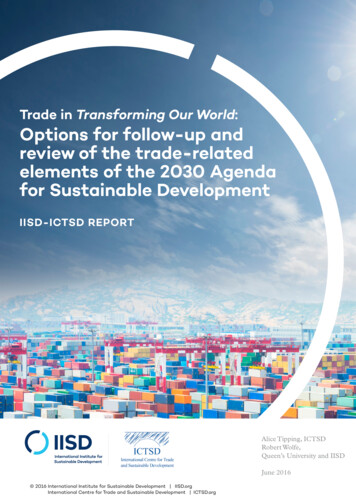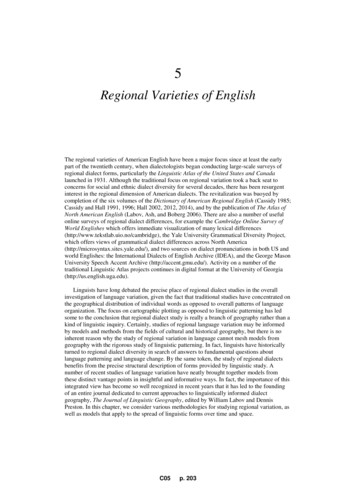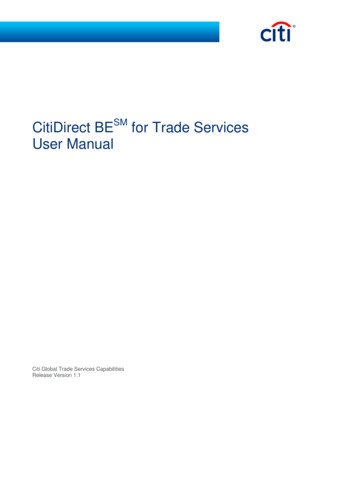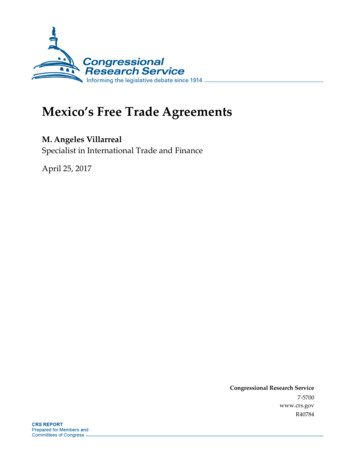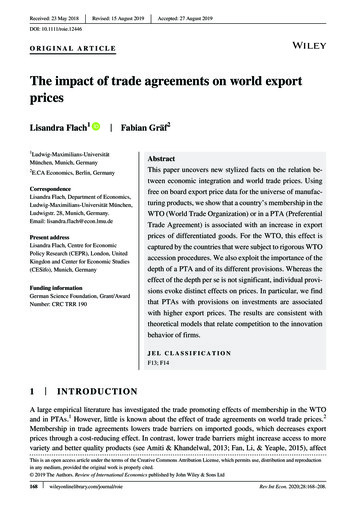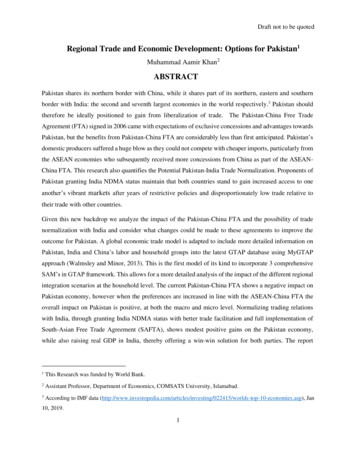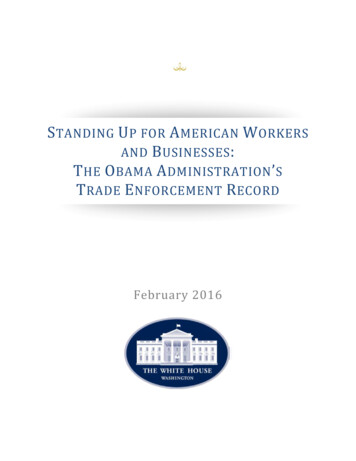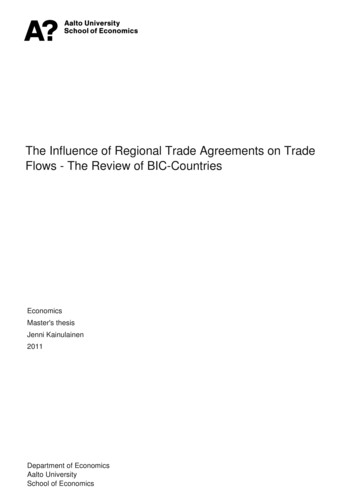
Transcription
The Influence of Regional Trade Agreements on TradeFlows - The Review of BIC-CountriesEconomicsMaster's thesisJenni Kainulainen2011Department of EconomicsAalto UniversitySchool of Economics
AALTO UNIVERSITY SCHOOL OF ECONOMICSAbstractEconomics Department, Master’s Thesis31.10.2011Jenni KainulainenTHE INFLUENCE OF REGIONAL TRADE AGREEMENTS ON TRADE FLOWS– THE REVIEW OF BIC - COUNTRIESThe target in this thesis is to study the influence of the regional trade agreements of the BICcountries (Brazil, India and China) on trade flows by using a gravity model. In this thesis it isinvestigated how much BIC-countries’ regional trade agreements explain of the bilateral tradeflows during the time period 2001-2008 and whether there is trade diversion. In addition, thecharacteristics of the countries influencing on trade creation and diversion are studied.In the empirical part the gravity model is used. Normally, the gravity model is used to explainthe variation in the country pairs’ trade flows and the influence of regional trade agreementson possible trade creation and diversion. The influence of regional trade agreements on tradeis estimated by using the OLS and Instrumental Variable (IV) estimations. Four culturalvariables were chosen to be instruments for a regional trade agreement variable.The estimation results indicate that the bilateral trade flows in the BIC-countries increased76 % during the time period 2001-2008. In addition to trade creation, a large trade diversionwas found. The post-estimation tests revealed that the OLS-model gives more reliable resultsthan IV-method when the language was included in cultural instruments. Opposite resultswere achieved when language was excluded from the instruments. From eight countrycharacteristics that were studied distance, common border and common continent had apositive impact on the trade creation, but negative impact on trade diversion. The impacts ofcultural variables on trade creation and diversion were mostly in line with the theory ofnatural trading partners.Keywords: international trade, integration, regional trade area, emerging countries, gravitymodel, instrumental variable –estimation.
Table of Contest1INTRODUCTION . 61.1 BACKGROUND AND MOTIVATION . 61.2 RESEARCH PROBLEM, METHOD AND MAIN RESULTS . 81.3 LIMITATIONS OF THE STUDY . 91.4 STRUCTURE OF THE STUDY . 102 TRADE LIBERALIZATION. 112.1 DESCRIPTION . 112.2 THE LEVELS OF INTEGRATION . 122.3 THE DEVELOPMENT OF THE REGIONAL TRADE LIBERALIZATION . 142.4 THE TRADE LIBERALIZATION OF THE BIC-COUNTRIES . 152.5 THE RECENT TRENDS . 163 THE ECONOMIC IMPACTS OF TRADE LIBERALIZATION. 193.1 TRADE CREATION . 193.1.1 The Idea of the Model . 213.1.2 The Trade Creation in the Oligopolistic Model . 213.2 TRADE DIVERSION . 273.2.1 The Idea of the Model . 283.2.2 The Trade Diversion in the Political Economy Approach . 293.2.3 How to Avoid Trade Diversion? . 343.4 THE INFLUENCE OF DISCRIMINATORY TARIFF REDUCTION BROADER LIBERALIZATION . 353.5 THE ROLE OF THE CHARACTERISTICS OF THE COUNTRY PAIRS IN TRADE LIBERALIZATION . 374 REVIEW OF THE EMPIRICAL LITERATURE . 414.1 EMPIRICAL STUDIES ON TRADE LIBERALIZATION . 424.2 EMPIRICAL STUDIES ON TRADE LIBERALIZATION IN EMERGING ECONOMIES . 455 GRAVITY MODEL AND METHODOLOGY . 485.1 GRAVITY MODEL . 485.1.1 The Gravity Model Framework . 505.2 METHODOLOGY . 545.2.1 Instrumental variable method . 542
6 DATA AND VARIABLES . 566.1 FORMULATING AND DESCRIPTION OF THE DATA . 566.2 VARIABLES . 576.2.1 Time variant variables . 576.2.2 Time invariant variables . 586.2.3 Instrumental variables . 596.3 DESCRIPTIVE ANALYSIS OF THE DATA . 617 EMPIRICAL RESULTS . 647.1 THE GENERAL IMPACT OF REGIONAL TRADE AGREEMENTS. 647.1.1 Additional Tests . 697.2 THE INFLUENCE OF SPECIFIC RTA ON TRADE. 717.3 THE IMPACT OF CHARACTERISTICS ON TRADE CREATION AND DIVERSION . 727.4 THE IMPACT OF CHARACTERISTICS ON THE RTAS OF BIC-COUNTRIES . 778 CONCLUSIONS . 81LIST OF REFERENCES . 85APPENDIXES . 923
Table of FiguresFIGURE 1: LEVELS OF ECONOMIC INTEGRATION .13FIGURE 2: THE DEVELOPMENT OF THE WORLD TRADE AND REGIONAL TRADE AGREEMENTS . 14FIGURE 3: HUB AND SPOKE REGIONAL TRADE AGREEMENTS. 17FIGURE 4 THE TRADE DIVERSION . 31FIGURE 5 THE DEVELOPMENT OF TRADE GROWTH .61TABLE 1: SUMMARY STATISTICS (2001-2008) . 62TABLE 2 THE INFLUENCE OF RTA ON TRADE . 65TABLE 3 CORRELATION BETWEEN RTAS AND THE CHOSEN INSTRUMENTAL VARIABLES .69TABLE 4 THE EFFECT OF CHARACTERISTICS ON TRADE CREATION . 73TABLE 5 THE EFFECT OF CHARACTERISTICS ON TRADE DIVERSION .75TABLE 6 THE EFFECTS OF SPECIFIC RTAS ON TRADE FLOWS.92TABLE 7 THE CHARACTERISTICS OF REGIONAL TRADE AGREEMENTS .93TABLE 8 THE CHARACTERISTICS, TRADE CREATION AND DIVERSION EFFECTS OF RTAS OF THEBIC-COUNTRIES . 94TABLE 9 THE COUNTRY TABLE .954
Definition of Essential ConceptsRegional Trade Agreement (RTA)Regional Trade Agreement is a trade agreement between two or more countries and is oneform of economic co-operation and integration. In RTA, only the trade barriers of the membercountries are reduced. Therefore, it is discriminatory. The countries that belong to the sameregional trade area do not have to be geographically close. (Sawyer & Sprinkle 2004, 205.)World Trade Organization (WTO a) uses the term RTA when discussing regional tradeagreements in general. In this thesis, I will use the term RTA as the main concept whendiscussing trade agreements of any kind mentioned below in general even though thecountries would be geographically distant.Preferential Trade Agreement (PTA)The loosest version of the regional trade agreement is Preferential Trade Agreement, which iscommonly an agreement between at least two countries. In PTA, the tariffs have not beenremoved. Instead, the tariffs have been lowered on goods produced in the member countries.(Panagariya 2000, 288.) Preferential trade agreement is the first stage of economic integration,which usually leads to free trade agreement.Free Trade Area (FTA)In the free trade area, all the tariffs are removed between the member countries. However, thecountries have their own external trade policies meaning that they still have their own tariffsto non-FTA countries. (Freund & Ornelas 2010, 141; Urata & Okabe 2007, 2.)Custom Union (CU)The countries that belong to the same CU, which is a form of RTA, remove the trade barriersbetween the members and have the same external tariff structure (Urata & Okabe 2007, 2).Within the CU, the good can move tariff free (Freund & Ornelas 2010, 141).5
1Introduction1.1 Background and motivationWhen discussing the regional trade agreements, the focus often is, what kind of influence theestablishment of the regional trade agreements has on the member countries. Usually theinterest is in modeling and predicting foreign trade flows, which has been an importantsubject in international economics. The influence of trade liberalization on trade has beenresearched from the viewpoint of developing and developed countries. However, there is lackof information, how the trade of emerging countries reacts on trade liberalization. Not manyresearchers have concentrated on emerging countries, like BIC-countries (Brazil, India andChina), as a group so far. Though, some studies about the trade liberalization of singleemerging countries have been made. In most of the research, the regional trade agreementshave influenced positively on trade flows. Mainly these researches have concentrated on thelargest and most known regional trade agreements such as EU, Mercosur and Nafta andgeneral regional trade agreement effect.There are reasons why more research has been done about the largest regional trade areasinstead of regional trade agreements to which emerging countries belong to. On the one handthe reason for this has been the protectionist measures that the emerging countries that are stillcategorized into developing countries use to protect their domestic industries. On the otherhand the non-membership of the World Trade Organization (WTO). The aim in this thesis isto study in the literature review and empirical part the influence of the regional tradeagreements on trade and welfare and discuss possible trade creation and diversion effects. Inthe empirical part, the analysis is done by using emerging country group BIC (Brazil, Indiaand China) and their trading partners as a review group.The emerging country group, BIC, is chosen to be the target because recent years thesecountries have received attention the most among emerging countries. As a country groupBIC is interesting to study, because of the increasing power the countries have in the worldeconomy as well as in the politics, due to China’s becoming the second largest economy inthe world in August 2010 based on the second-quarter GDP (China overtakes Japan-- 2010).Above all, the large share of their GDPs and exports in the world total has increased theinfluence of the economies in the world economy. Their GDPs represent 13.5 % of the world6
GDP and exports 11 % of the total world exports (The World Bank b, 28.1.2011).1 For thesereasons the investment bank Goldman Sachs gave the name BRIC-countries to theseeconomies including Russia in the report in 2003. However, by comparing countries withtheir GDP per capita, all these countries are still categorized as developing countries oremerging countries2 (IMF 2010, 2.)The influence of regional trade agreements can be modeled with various trade liberalizationtheories that underline the role of the government in the decision making. With the gravitymodel framework it is tried to find out in the empirical part, whether the influence of regionaltrade agreements on trade in a case of BIC-countries is in line with the theories, and what isthe trade effect of the regional trade agreements. It is important to make clear that BICs assuch are not a regional trade area.3There are many reasons to think over, why the increasing number of emerging country groupBIC’s regional trade agreements, is significant. First of all, the establishment of regional tradeareas has been significant for the world economy because the globalization has developed viatrade integration. Second, by studying this, it is possible to find out what kind of influence thetrade liberalization has had on this fast growing country group’s trade and especially exports.In general, developing countries are known in their export-led growth strategies. According tothe export-led growth theory, the increase in exports as a consequence of regional tradeagreements may have played an important role in the growth of the countries. This is becausethe domestic industries have boosted the productivity to meet the demand for the increasedexports. (Crawford & Fiorentino 2005, 2.) Third, if it is known how much regional tradeagreements have influenced on BIC’s export growth and other possible factors that haveinfluenced on trade flows, it is easier to analyze and predict the effects of trade policies.Especially, in the interest here is the growing importance of the BIC-countries in the worldeconomy.1Author’s calculations are based on the World Bank data. Data are in current U.S. dollars for GDP and exports.World Bank categorizes Brazil, China and India developing countries. In the categorization of the World BankAtlas method, which is another way to make a difference between the relative size of economies in terms ofgross national income. In addition the World Bank Atlas method is used to classify countries in low, middle andhigh-income categories and to set lending eligibilities. In this categorization India and China belongs to lowermiddle income and Brazil into upper middle income. (The World Bank a, 14.05.2011)23BIC-countries (Brazil, India and China) as such are not a regional trade area. Actually, all of them are notmembers in any certain regional trade area. (WTO c)7
In addition to the influence on exports, the trade liberalization may have significant influenceon BIC-countries and the rest of the world to survive from the recent financial crisis. In therecent discussion about the regionalism the subject under review has been, whether we shouldcarry on regionalism or try to slow it down. Especially during the financial crisis 2008-2009,under the discussion was that which one is better for countries to survive from the crisis protectionism or trade liberalization? Liberalization of trade was the answer according toFreytag and Voll (2009) in their research based policy analysis. Freytag and Voll (2009)underlined the importance of emerging countries in this after crisis liberalization and reregulation process. The efforts to avoid protectionism could help the BRICs and the rest of theworld to survive from the recent financial crisis. (OECD 2009, 1.) Even though theglobalization through the trade integration has already come a long way, there is still need forit, which supports the importance of the trade liberalization as a topic. Therefore the role ofthe emerging countries in the trade liberalization should be reviewed.1.2 Research problem, method and main resultsThe aim in the thesis is to study the influence of the regional trade agreements on trade flowsby using a gravity model. Specifically, the goal is to find out how much the regional tradeagreements of the BIC-countries explain of the bilateral trade flows during the period 20012008 and whether there is trade diversion. In addition, the country characteristics influencingon trade creation and diversion are studied. The results are also compared with the previousstudies and considered whether the results are in line with the previous research. Differentlyfrom previous studies an emerging country group is the target group. I extend the previousstudies by concentrating only on emerging countries and their trade flows and trying tominimize the bias by instrumenting the RTA variable.The model that is used in the empirical part is the gravity model, which is used to explain thevariation in the country pairs’ trade flows and the influence of regional trade agreements onpossible trade creation and diversion. In addition to an OLS-estimation, I also use aneconometric method, the Instrumental Variable estimation (IV). Commonly problems such asendogeneity, omitted variables and measurement errors appear in the linear regression fordifferent reasons. Anyhow, at least the endogeneity problem can be solved by usinginstrumental variable estimation. (Baum 2006, 185.) In addition, IV-estimation enables me to8
avoid the biased and inconsistent estimates that may occur with panel data on the standardOLS-estimation. Most of the studies that have previously estimated the gravity model use theordinary least square (OLS) method to cross section data or other than IV-estimation.My estimation results indicate that the bilateral trade flows in the BIC-countries increased76 % during the time period 2001-2008 when the model was estimated with the OLS-model.OLS-model turned out to give more reliable results than IV-method when language variablewas included in cultural instruments. Opposite results were achieved when language wasexcluded from the instruments. In addition, a large trade diversion was found. From eightcharacteristics that were studied distance, common border and common continent had apositive impact on the trade creation and opposite negative impact on trade diversion in thecase of BIC-countries. In addition, the impacts of cultural variables on trade creation anddiversion were mostly in line with the theory of natural trading partners.1.3 Limitations of the StudyThere are some limitations in my study. In the empirical part, I study only the regional tradeagreements of the emerging countries. From the emerging country group BRICs, I willconcentrate on Brazil, India and China. Because Russia is not a member of WTO, it isexcluded from the study. In this way, the emerging country group under review becomesmore homogenous. According to the WTO’s definition, the regional trade agreements includeboth free trade areas and custom unions. Also preferential trading agreements (PTA) areincluded in the study, because they develop to be regional trade agreements at a later date andWTO categorizes preferential trade agreement to be one form of the regional tradeagreements. In addition, I limit the data period to end before the latest financial crisis, becauseonly China among some other countries was growing during that exceptional time. The worldtotal growth was actually diminishing (The World Bank b, 28.1.2011).4 Therefore we mayavoid some bias in the data. I concentrate only on discriminatory tariff reduction meaning thatI exclude the multilateral liberalization from my study. In addition, I will not pay too muchattention to Common Market and Economic Union as forms of trade integration.4According to the World Bank Development Indicators, the annual percentage growth rate of GDP of the worldwas -1.95% in 2009. The annual percentage growth rate of GDP is calculated at market prices based on constantlocal currency by author.9
1.4 Structure of the StudyThe structure of the study is following. In the first chapter, introduction, the research problemand the motivation for the study are described. The second chapter consists of explanation ofthe development of trade liberalization and the recent trends. In the third chapter, it isdiscussed, how tariff reduction affects the member countries in terms of trade and welfare andthe possible consequences on non-member countries are discussed. Also it is discussed thecharacteristics of the countries that make regional trade agreements more trade creating ordiverting. Chapter 4 is the review of the empirical literature. First, it is discussed the generalempirical studies about the trade liberalization and then the focus is moved to the studies ofthe emerging economies. In the fifth chapter, the gravity model framework that is used in theempirical part is explained in detail. Also the instrumental variable -methodology is gonethrough. Chapter 6 concentrates on describing the data and possible limitations to theempirical part. The results of the empirical part are represented in Chapter 7. Therefore, thestudy is concluded in Chapter 8 and possible ideas for the future research represented.10
2 Trade LiberalizationIn this chapter, I will discuss trade liberalization more deeply and consider how the regionaltrade agreements have developed during the years. This chapter, as the thesis, concentrates ondiscriminatory tariff reduction. First, I will present the features of the trade liberalization to beable to understand the context of this thesis.2.1 DescriptionEconomic co-operation and integration have a long history. Formal and informal tradeagreements have existed wherever people have traded. (Plant & Taghian 2008, 1.) In the half–century before World War I some countries already enjoyed free trade in Europe. Though,this system of free trade did not emerge from any continent-wide agreement. Instead, mainlythe series of bilateral treaties were established. (De Melo & Panagariya 1996, 122.) Laterbroader trade liberalization began when the European integration started to develop in the1950 in the form of European Economic Community (EEC) that nowadays is known asEuropean Union. (Berry & Hargreaves 2007, 1-8.) The European integration led throughcontagion and imitation effects on the trade liberalization continue steadily. (Pomfret 2007,924.) Since the early 1990s regional trade integration has been the main form of tradeliberalization. (Calvo-Pardo, Freund & Ornelas 2009, 2). These days, the most knownregional trade agreements are EU (European Union), NAFTA (North American Free TradeAgreement), MERCOSUR (Southern Common Market), ASEAN (The Association ofSoutheast Asian Nations) and COMESA (The Common Market for Eastern and SouthernAfrica) (WTO a, 30.1.2011).Trade liberalization is a form of trade policy. In the trade liberalization, the countries thathave opened their trade to international trade remove both tariff barriers and non-tariffbarriers to trade. The trade liberalization increases by the formation of new trade areas or bythe expansion of the existing trade areas.11
In the trade liberalization, the agreement can be (Crawford & Fiorentino 2005, 4):i) Between two countries (bilateral)ii) Between a country and already existing regional trade area (bilateral) oriii) Between many countries (plurilateral).The trade liberalization is implemented through regional trade agreements and the aim is toremove both tariffs and non-tariff barriers (import quotas, export restraints, and exportsubsidies) to trade. A tariff is a tax on either imported or exported good. The effect of importtax is symmetrical to the effect of export tax. (Sawyer & Sprinkle 2004, 132-133.) A tariff isthe oldest form of trade policy and traditionally it has been a source of government income,even though the main purpose has usually been to protect domestic industries (Krugman &Obstfeld, 2009, 183). There are different types of tariffs as specific tariffs, ad valorem tariffsand compound tariffs (Sawyer & Sprinkle 2004, 132-133). The importance of tariffs hasdecreased recently and governments prefer to protect domestic industries through a variety ofnontariff barriers (Krugman & Obstfeld 2009, 183). The reasons to establish regional tradeagreements and the benefits of forming RTA have been defined mostly by economic termsthat will be gone through in Chapter 3. (Plant & Taghian 2008, 1.)2.2 The Levels of IntegrationThere are different levels of integration. Economic integration can apply to only productmarkets as well as the integration can be deepened to the markets of production (labor andcapital) and services as it is done in the custom union such as European Union where there isa free move of goods, services, labor and capital (Berry & Hargreaves 2007, 4-5). When thefirst trade liberalization, the establishment of ECC, took place, only tariffs and quotas wereremoved. This was the lowest level of integration. The ECC is the origin of European Union.(Berry & Hargreaves 2007, 6.)When discussing the trading blocs, the main concept is regional trading agreements (RTA). Inthe literature terms preferential trade area (PTA), free trade area (FTA) and custom union(CU) are often used. Both Free Trade Area (FTA) and Custom Union (CU) are forms ofregional trade agreements. From the regional trade agreements, approximately 90 % are free12
trade areas and 10 % are custom unions. (WTO a, 30.1.2011.) From Figure 1 below the levelsand typical characteristics of economic integration can be observed for different levels ofeconomic integration.Common EconomicPolicies and CommonCurrencyIntragroup Capital andLabor MobilityCommon External TariffsRemoval of IntragroupTariffsReduction of SomeIntragroup TariffsPreferentialTradeAgreementFree TradeAreaCustom UnionCommonMarketEconomicUnionFigure 1: Levels of Economic Integration (Sawyer & Sprinkle 2004, 207)The differences between the levels of economic integration can be noted in the vertical axisfrom Figure 1 above. In the horizontal axis, there are the different levels of economicintegration. The economic union is the deepest form of economic integration when thepreferential trade agreement is the loosest. The economic union includes all the looser formsof economic integration. European Union is an excellent example of the economic union. Inpreferential trade agreement only some tariffs are removed, but in custom union all theintragroup tariffs are removed and countries in the bloc set a common external tariff. (Sawyer& Sprinkle 2004, 207.) Therefore, depending on the level of economic integration, differentcharacteristics are typical for the agreement. This thesis concentrates in both literature reviewand empirical part only the three least restrictive levels of economic integration known asPTAs, FTAs and CUs.13
2.3 The Development of the Regional Trade LiberalizationOne of the main international developments in recent years has been the growth of regionaltrade agreements (RTA). WTO announced there were overall 283 5 regional trade agreementsthat include either or both goods and services, in force and 191 under negotiation in July 2010(WTO a, 30.1.2011). As Figure 2 below depicts, the number of RTAs has increasedconstantly. It is interesting to perceive that the world trade has grown in the same pace. Thefigure is based on the agreements that can include either goods or both goods and services andare in force according to WTO.35,000250RTAs in forceforce (left)RTA's(left)World Trade, bn USD 0000,00001950196019701980199020002010Figure 2: The Development of the World Trade and Regional Trade Agreements (WTO d,21.9.2010)It can be noted from the above Figure 2 that there have been three peaks in the developmentof the regional trade areas that are gone through in the following paragraphs. The tradeliberalization expanded to developing countries in the 1970s when the Generalised System ofPreferences (GSTP) was established in 1971. Therefore, the extensions of tariff preferencesfor developing countries become possible. (Pomfret 2007, 924.) Since 1970 the amount ofRTAs has been on the increase.5This list includes either or both goods and services. Divergences in RTA numbers are due to different methodsused to count agreements. A complete list of RTAs notified by the GATT or WTO is in the webpage:http://www.wto.org/english/tratop e/region e/
Four cultural variables were chosen to be instruments for a regional trade agreement variable. The estimation results indicate that the bilateral trade flows in the BIC-countries increased 76 % during the time period 2001-2008. In addition to trade creation, a large trade diversion . agreement



